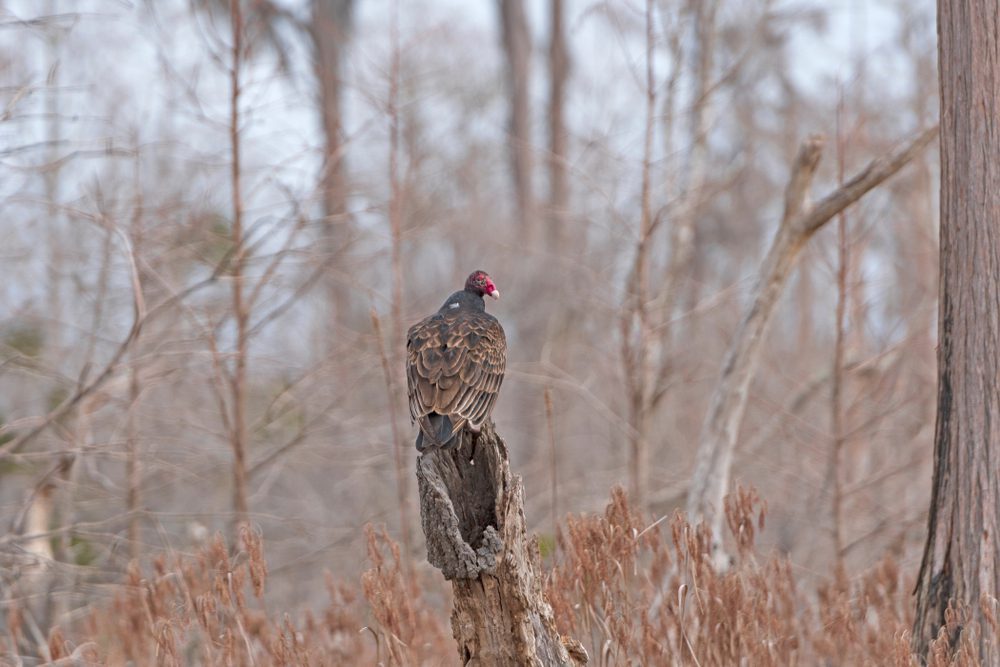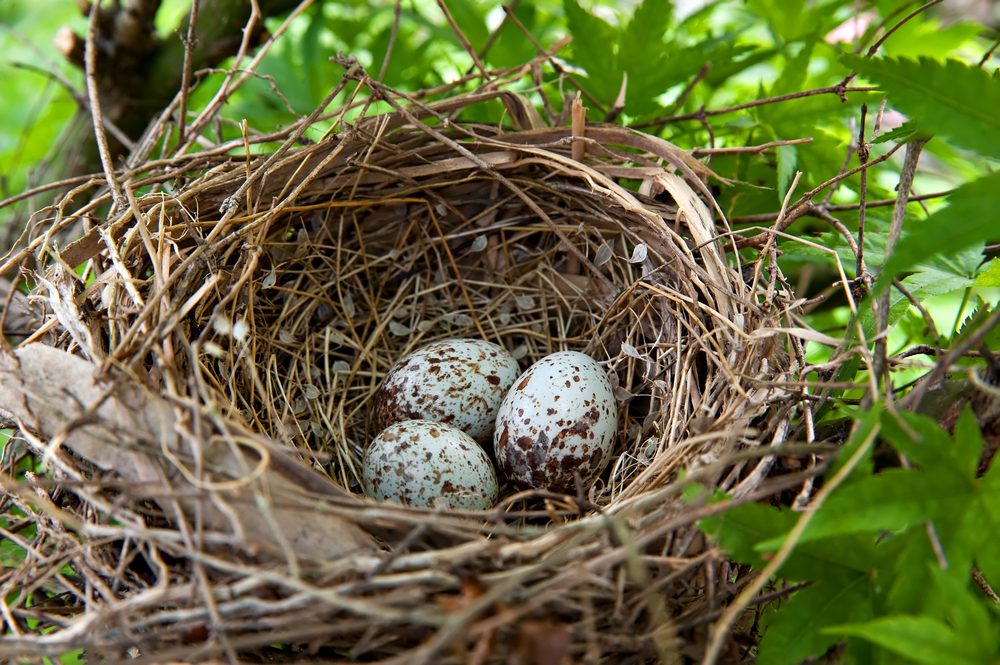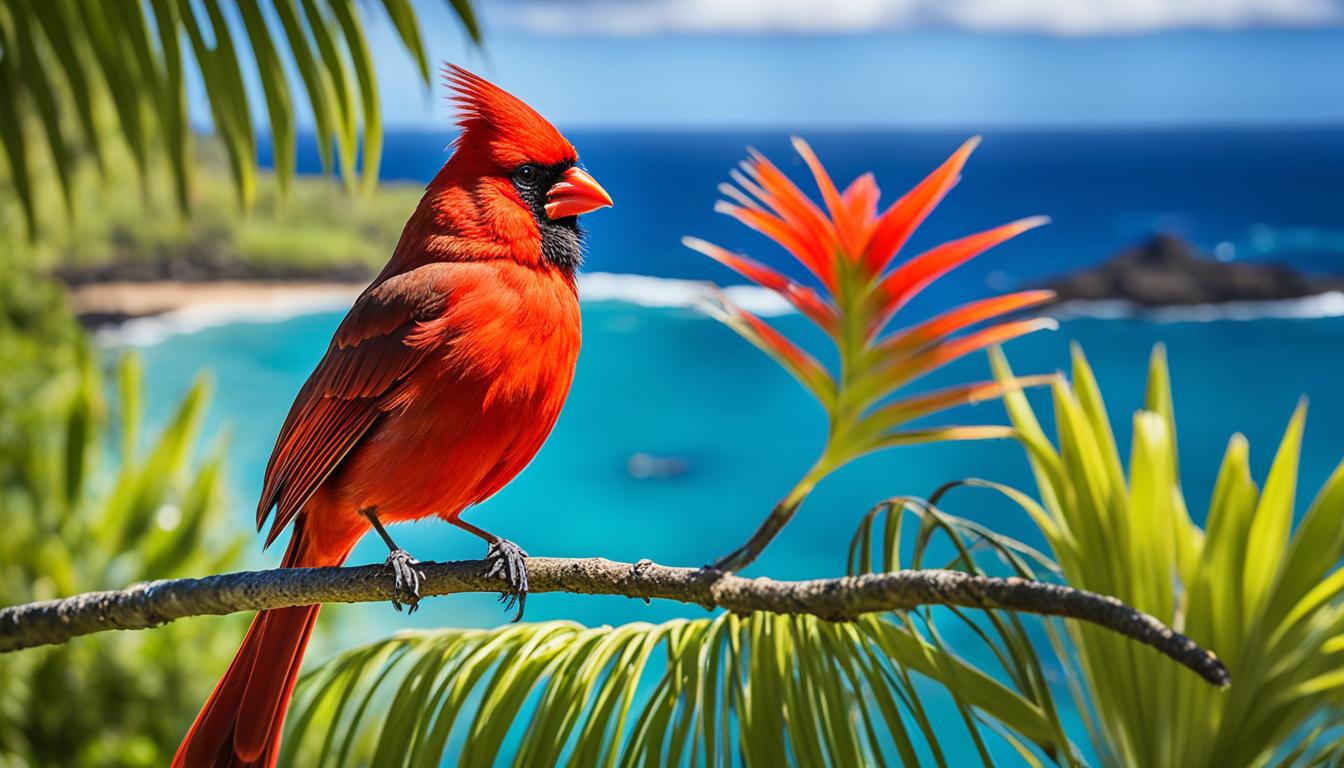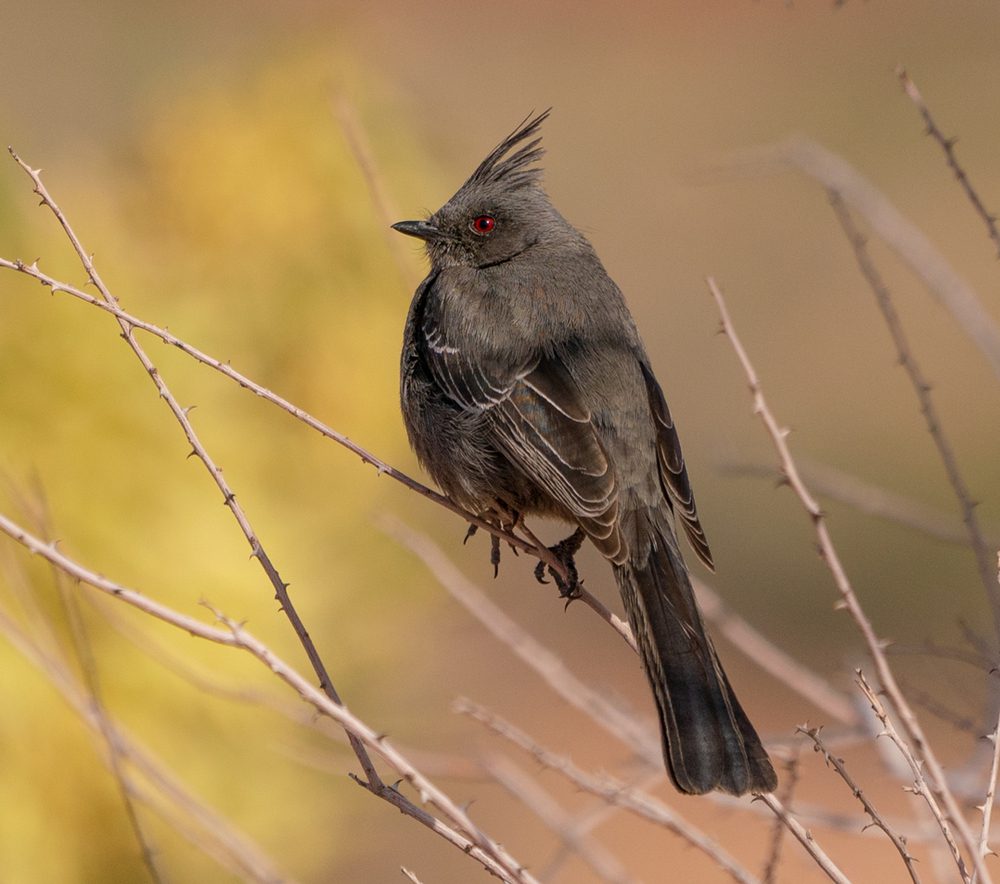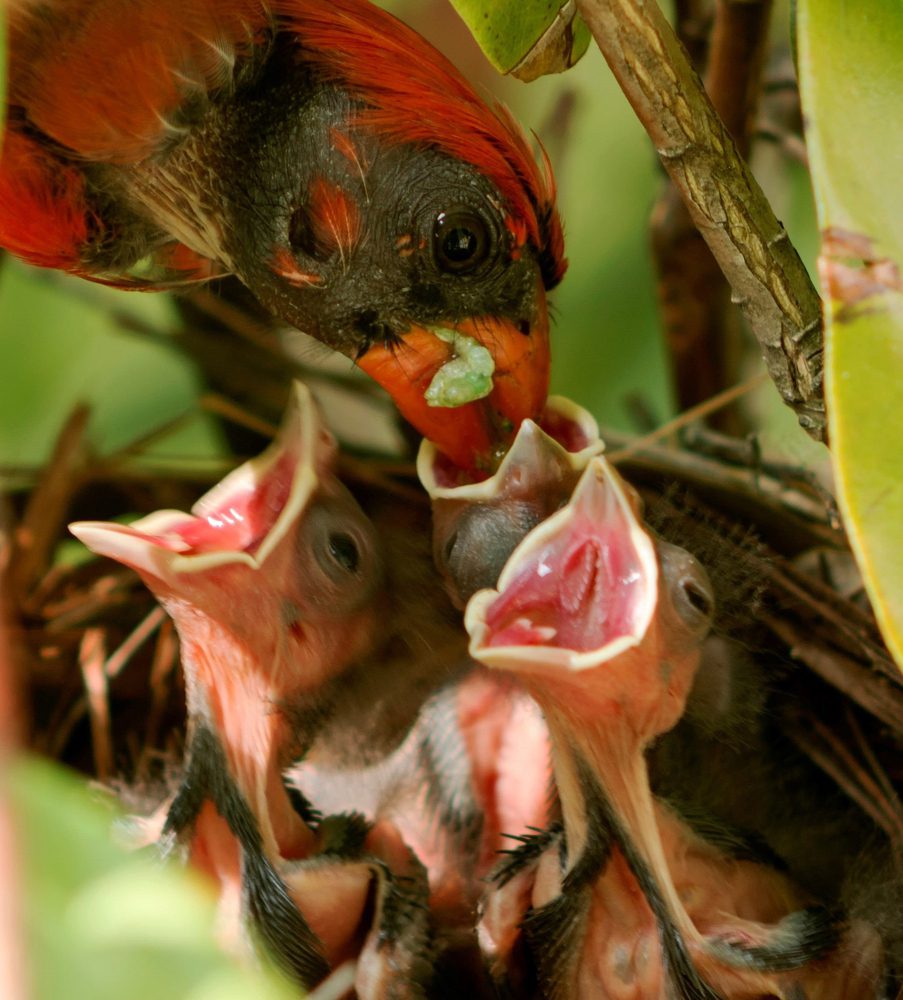Turkey Vulture Maine – Did you know that Turkey Vultures can be found in Maine, soaring high in the sky and mesmerizing birdwatchers? These magnificent birds, with a wingspan of about 6 feet, play a vital role in the state’s ecosystem. From their scavenging behavior to their unique characteristics, there’s so much to discover about these fascinating creatures.
Key Takeaways:
- Turkey Vultures are commonly sighted in Maine, particularly in the I-295 corridor between Yarmouth and Freeport.
- They are known for their bald heads, red, wrinkled skin, and distinctive soaring flight.
- Turkey Vultures are scavengers, feeding primarily on carrion, and they have a crucial role in cleaning up carrion and preventing the spread of diseases.
- Maine offers excellent birdwatching opportunities, including the chance to spot these majestic birds in their natural habitat.
- Conservation efforts are necessary to protect the habitats of turkey vultures and ensure the survival of Maine’s avian population.
Table of Contents
The Habitat of Turkey Vulture Maine
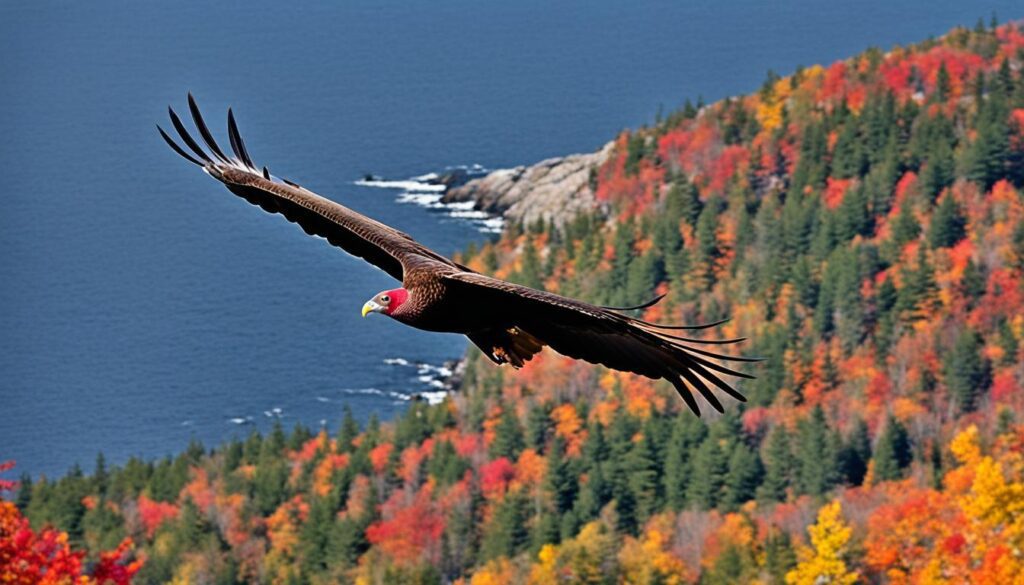
Turkey Vultures in Maine thrive in diverse habitats that offer open areas and access to large bodies of water. These majestic birds are commonly found near forests, fields, and wetlands, as these environments provide the ideal conditions for their survival and breeding.
In their search for Turkey Vulture habitat, these birds often take advantage of the abundant food sources found in wetland areas, such as marshes and swamps. The presence of carrion in these ecosystems ensures a plentiful food supply for the vultures, helping to sustain their population.
The nesting habits of Turkey Vultures are equally adaptable. These birds construct their nests on the ground or in trees, using sticks, leaves, and other natural materials. This flexibility allows them to thrive in a variety of terrain, ensuring their ability to reproduce and maintain a stable population.
Conservation efforts focused on protecting Turkey Vulture habitats are crucial for the long-term survival of these magnificent birds in Maine. By safeguarding the forests, fields, wetlands, and wetland areas they rely on, we can contribute to the preservation of their population and foster a healthy ecosystem.
Turkey Vulture Habitat Preferences in Maine
| Habitat Type | Description |
|---|---|
| Forests | Turkey Vultures can be found near forests, utilizing the resources available and seeking shelter within the trees. |
| Fields | These birds are often observed in open fields, where they can easily spot carrion and take flight. |
| Wetlands | Wetland areas such as marshes and swamps provide an abundance of carrion as food sources, attracting Turkey Vultures. |
Note: The table provides an overview of the different habitat types preferred by Turkey Vultures in Maine. It demonstrates their adaptability and highlights the importance of conserving these habitats for their continued presence in the state.
By prioritizing bird habitat conservation and preserving the diverse landscapes that Turkey Vultures rely on, we can ensure the survival of these fascinating creatures and contribute to the protection of Maine’s wildlife.
Behavior and Feeding Habits of Turkey Vultures
Turkey Vultures, also known as cathartes aura, are fascinating scavenging birds known for their distinctive behavior and feeding habits. They are carrion eaters and play a crucial role in the ecosystem as efficient carrion cleaners. Let’s explore their behavior and feeding habits in more detail.
Highly Social Birds
Turkey Vultures are highly social birds that often gather in large groups called “kettles.” These kettles consist of several birds soaring together in the sky, using thermals to gain altitude and travel long distances. It’s a spectacular sight to behold, witnessing these majestic birds soaring gracefully through the air.
A Keen Sense of Smell
One of the remarkable characteristics of turkey vultures is their keen sense of smell. They can detect carrion, or decaying animal matter, from miles away. This exceptional olfactory ability allows them to locate food sources efficiently, even when concealed by dense vegetation or underground. Their sense of smell is highly specialized and aids in their role as carrion eaters.
Tearing into Carcasses
When a turkey vulture locates carrion, it uses its strong beak to tear into the carcass and access the meat. Their beaks are well-adapted for this purpose, enabling them to break through tough skin and membranes to reach the nutritious flesh within. This feeding behavior allows turkey vultures to consume carrion that might otherwise go to waste.
Removing Carrion and Reducing Disease
In addition to scavenging carrion, turkey vultures also serve a vital ecological role in the decomposition process. By consuming carrion, they effectively remove potential disease vectors from the environment, reducing the risk of the transmission of pathogens. This helps maintain the overall health and hygiene of the ecosystem in which they reside.
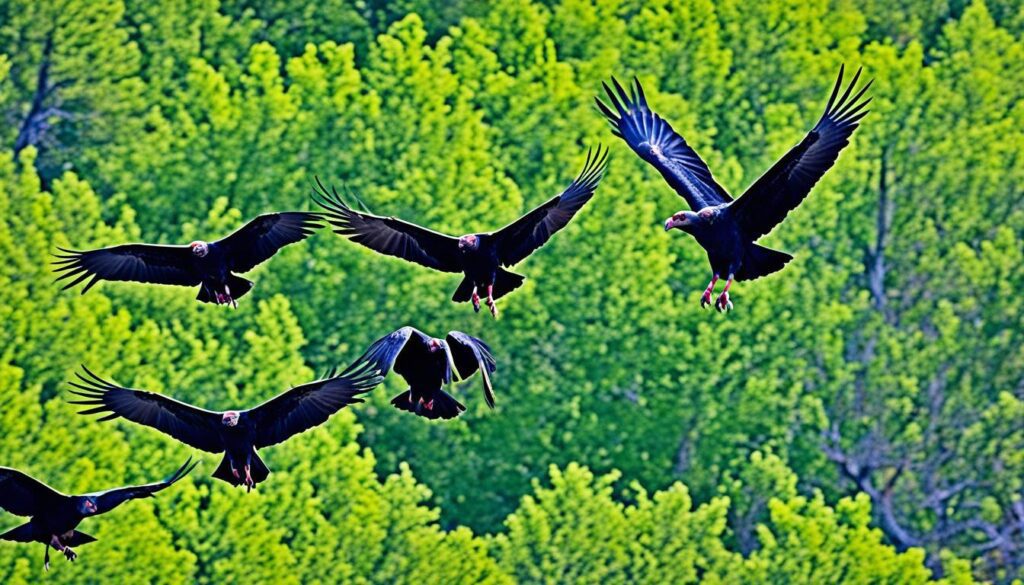
With their collective behavior, keen sense of smell, and carrion-eating habits, turkey vultures contribute significantly to the ecological balance of their habitat.
| Key Behavior | Description |
|---|---|
| Highly Social | Turkey vultures often gather in large groups known as “kettles.” |
| Keen Sense of Smell | They can detect carrion from miles away, enabling efficient food location. |
| Tearing into Carcasses | Using their strong beaks, turkey vultures tear into carcasses to access the meat. |
| Removal of Carrion | By consuming carrion, they reduce the risk of disease transmission and aid in waste disposal. |
Nature has truly crafted these birds into unique and essential carrion eaters, ensuring the preservation of the delicate balance within the ecosystem.
Turkey Vultures and Bird Migration in Maine
Turkey Vultures in Maine embark on incredible journeys during their annual migration. These majestic birds spend the winter months in southern regions, seeking warmer climates. As the seasons change and spring arrives, they make their way back to Maine, reclaiming their breeding grounds once again.
Migrating turkey vultures follow well-established migration routes that have been passed down through generations. They navigate across vast distances, demonstrating their remarkable navigational abilities.
Birdwatchers in Maine are fortunate to witness this awe-inspiring spectacle each year. As the turkey vultures return, they create a mesmerizing display in the sky, with their large wingspan and graceful flight. It’s a testament to the wonders of avian migration.

The Marvels of Bird Migration
Bird migration is a fascinating phenomenon that has captivated scientists and enthusiasts alike for centuries. It is a natural instinct deeply ingrained within the bird species, driven by various factors such as seasonal changes, availability of food, and breeding patterns.
Migratory birds cover vast distances during their journeys, crossing mountains, oceans, and even continents. They rely on celestial cues, magnetic fields, and landmarks to navigate their way. Their ability to find their way back to the same breeding grounds each year is nothing short of remarkable.
| Migration Patterns | Maine Bird Species |
|---|---|
| Turkey vultures | Scarlet Tanager |
| Warblers | Common Loon |
| Plovers | Black-capped Chickadee |
Here are a few more remarkable bird species known for their migratory patterns in Maine:
- Scarlet Tanager
- Common Loon
- Black-capped Chickadee
“Bird migration is a testament to the incredible adaptability and resilience of these winged creatures. It’s a reminder of the interconnectedness of our natural world and the importance of preserving their habitats.” – John Audubon
Maine’s diverse bird species and its strategic location along the Atlantic Flyway make it an ideal destination for birdwatchers and nature enthusiasts. The state’s rich natural landscapes, including forests, wetlands, and coastal areas, provide essential habitats for both resident and migratory birds.
Protecting Maine’s Bird Species
Conservation efforts are crucial for preserving the habitats of Maine’s bird species, including the turkey vultures. By protecting their habitats, we ensure the survival of these remarkable creatures for future generations to admire.
Supporting organizations like the Maine Audubon and participating in citizen science initiatives can make a difference in bird conservation. Additionally, responsible birdwatching practices, such as keeping a safe distance and avoiding disturbance, help minimize stress and protect the well-being of these magnificent birds.
By appreciating and understanding the significance of bird migration, we can cultivate a deeper respect for nature and contribute to the protection of our feathered friends.
Identification & Characteristics of Turkey Vultures
Turkey Vultures are easy to spot and pretty cool to watch. They have dark brown to black feathers that really stand out, especially with their bald heads and red skin. When they fly, their long and wide wings help them glide smoothly and easily in the sky, which is pretty awesome to see. They also have a unique way of walking, wobbling from side to side, which makes them stand out even more. Since they’re among the bigger birds in Maine, their size alone makes them easier for birdwatchers to notice.
If you see a bird with dark feathers, a bald head, red skin, and big wings, you’re probably looking at a turkey vulture. These features, along with how big they are, make turkey vultures a cool and easy bird to recognize for anyone into birdwatching.
Turkey Vultures and the Ecological Importance in Maine
Turkey Vultures play a vital role in maintaining the ecological balance in Maine. As scavenger species, they perform the crucial task of carrion cleanup, preventing the spread of diseases and keeping the environment clean and healthy. These magnificent birds act as nature’s recyclers, efficiently disposing of animal carcasses and reducing waste.
If Turkey Vultures weren’t around, we’d have a big problem with rotting stuff everywhere, which could make animals and people sick and mess up nature’s balance. By munching on dead animals, Turkey Vultures help keep Maine’s outdoors healthy and everything running smoothly.
The Ecological Role of Turkey Vultures
The ecological role of turkey vultures extends far beyond their scavenging capabilities. Their efficient carrion cleanup helps maintain the ecosystem’s health by reducing the risk of disease transmission. By removing decaying organic matter, turkey vultures prevent the proliferation of harmful pathogens and bacteria, ensuring a safer environment for both animal and human populations.
Furthermore, turkey vultures contribute to nutrient cycling within the ecosystem. Their consumption of carrion converts organic matter into valuable nutrients, which are then reintroduced into the soil. This process plays a crucial role in nutrient recycling and enriches the surrounding habitat, supporting the growth and development of various plant species.
The Importance of Ecosystem Balance
Ecosystem balance is crucial for maintaining the overall health and sustainability of natural environments. Each species, including turkey vultures, plays a particular role that contributes to the delicate balance within ecosystems. The scavenging behavior of turkey vultures ensures the efficient removal of carcasses, preventing the accumulation of decaying matter that could disrupt the ecosystem’s equilibrium.
By effectively controlling the abundance of carrion, turkey vultures help regulate the population dynamics of scavenger species and prevent overconsumption of available resources. Their presence creates a harmonious balance in the ecosystem, allowing other organisms to thrive and ensuring the long-term stability and resilience of Maine’s natural habitats.
| Ecological Contributions of Turkey Vultures | Summary |
|---|---|
| Scavenger Role | Efficient carrion cleanup, reducing disease transmission |
| Nutrient Cycling | Conversion of organic matter into valuable nutrients |
| Ecosystem Balance | Maintaining equilibrium and regulating population dynamics |
Birdwatching Opportunities and Conservation Efforts in Maine
If you’re a bird enthusiast, Maine offers an abundance of birdwatching opportunities that cater to both beginners and experienced birders. One of the fascinating bird species you may encounter during your birdwatching adventures is the turkey vulture.
Turkey vultures (Cathartes aura) are majestic birds known for their soaring flight and scavenging behavior. They can be spotted in various regions of Maine, adding excitement to your birdwatching experience.
To maximize your chances of observing turkey vultures and other bird species in their natural habitat, consider visiting designated birding trails and wildlife sanctuaries in Maine. These areas provide prime opportunities to witness the diverse avian population of the state.
By engaging in birdwatching activities, you not only indulge in a rewarding hobby but also contribute to wildlife conservation efforts. Maine’s diverse bird species are essential for maintaining the balance of its delicate ecosystems.
“Birdwatching not only brings joy to enthusiasts like me but also plays a crucial role in bird species conservation. We have a responsibility to protect the habitats that these magnificent creatures rely on for survival.”
To help preserve the habitats of turkey vultures and other bird species in Maine, consider supporting wildlife conservation organizations and participating in local initiatives. Your contribution can make a significant difference in the long-term survival of these fascinating creatures.
Exploring Birding Trails in Maine
Maine boasts a plethora of birding trails that showcase the state’s stunning natural beauty and diverse birdlife. Below are some notable birding trails where you have a good chance of spotting turkey vultures:
| Birding Trail | Location |
|---|---|
| Acadia Birding Festival Trail | Bar Harbor |
| Scarborough Marsh Audubon Center | Scarborough |
| Moosehorn National Wildlife Refuge | Baring |
These birding trails offer breathtaking scenery and opportunities to observe a variety of bird species. Whether you’re a seasoned birder or a novice, exploring these trails will undoubtedly enhance your birdwatching experience.
Conclusion
Turkey Vultures are awesome birds that play a big part in keeping Maine’s outdoors healthy. They’re like nature’s cleanup crew, eating up dead animals and stopping diseases from spreading. It’s super important for us to help protect these birds and their homes.
When we work to save these birds, we’re also helping to keep Maine’s wildlife safe and sound for the future. Turkey Vultures are an important piece of the puzzle in our environment, helping to keep everything in balance.
Let’s keep standing up for wildlife and spread the word about how cool and important these birds are. By doing this, we’re making sure turkey vultures, and all of Maine’s nature, stays thriving and healthy.
maybe you also want to see turkey vulture in texas.
FAQ
Where can I find turkey vultures in Maine?
Turkey vultures can be found in Maine, particularly in the I-295 corridor between Yarmouth and Freeport.
What is the wingspan of a turkey vulture?
Turkey vultures have a wingspan of about 6 feet.
What do turkey vultures eat?
Turkey vultures are primarily scavengers and feed on carrion.
What are the distinct characteristics of turkey vultures?
Turkey vultures have dark brown to black feathers, bald heads, and red, wrinkled skin.
How do turkey vultures contribute to the ecosystem of Maine?
Turkey vultures play a vital role in the ecosystem by cleaning up carrion and preventing the spread of diseases.
Are turkey vultures migratory birds?
Yes, turkey vultures in Maine are migratory birds, spending the winter in southern regions and returning to Maine during the spring and summer.
Where can I go birdwatching in Maine?
Maine offers excellent birdwatching opportunities, including designated birding trails and wildlife sanctuaries.
How can I support the conservation of turkey vultures and other bird species in Maine?
You can support conservation efforts by protecting the habitats of turkey vultures and other bird species and by contributing to wildlife conservation organizations.

